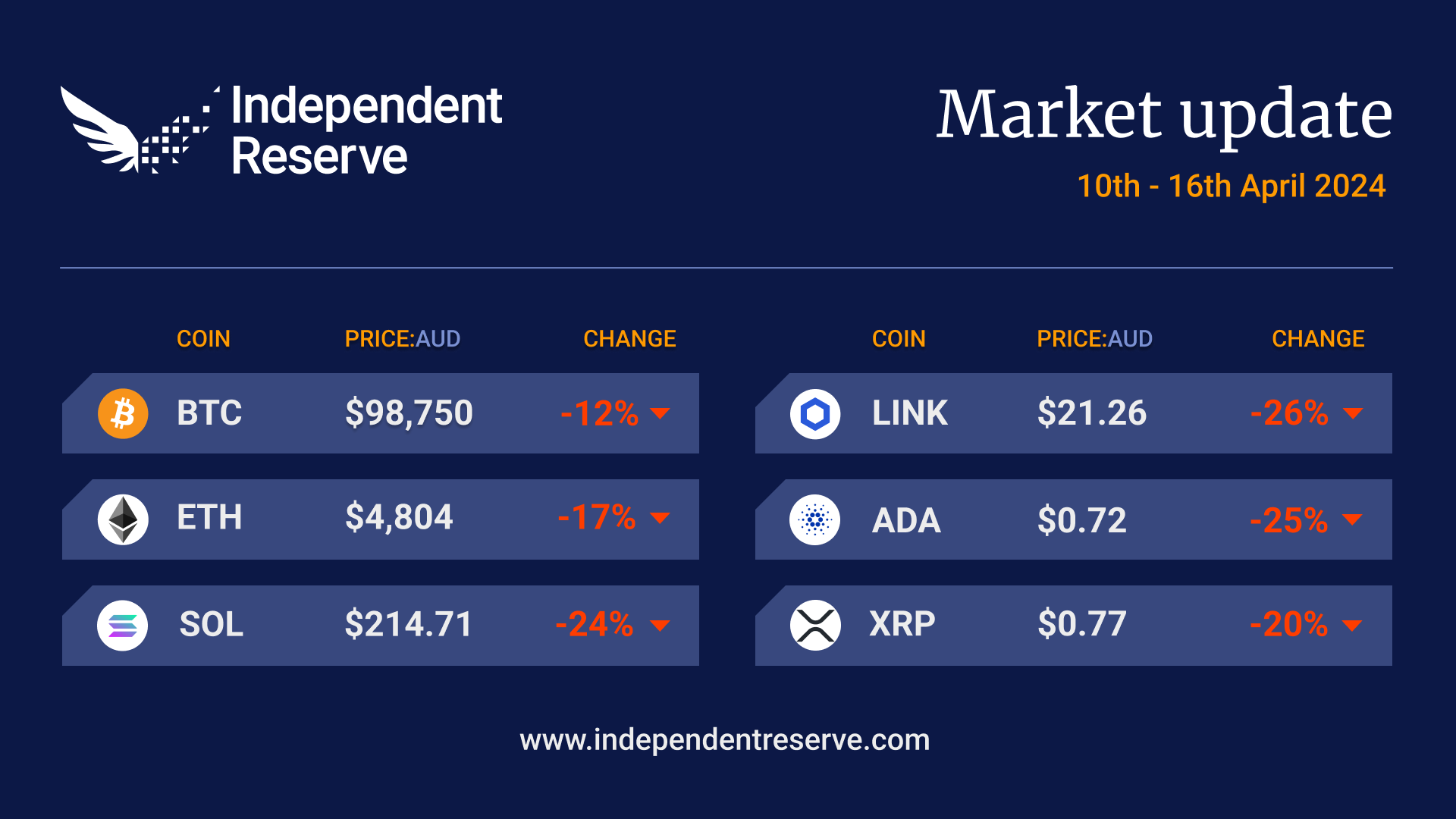Market Update 11th – 18th March 2020
In Markets
It’s been a horror week across every financial market and asset class, and crypto is no exception. Late last week the price plunged 52% in 24 hours – before bouncing off the bottom – for the Bitcoin halving nobody wanted. Bitcoin is currently trading above $9,000 and finishes the week 32% down. Despite this, it’s only lost 22% in 2020 so far. The only coins in the green this week were stablecoins like Tether and USDC – both up around 6% during the crash as investors tried to cash out. The Tether market cap has increased above US$5 billion for the first time and USDT on exchanges hit an all time high of $1.23 billion. Ethereum is down 42% for the week, XRP lost 30.3%, Bitcoin Cash (-32.3%), Litecoin (-32%), Bitcoin SV (-44%), EOS (-35%) and Stellar (-28%).

Source: Independent Reserve Bitcoin/AUD chart
In Headlines
Black swan event
The price crash was the biggest one day fall in Bitcoin’s history in dollar terms and saw it breach the 200-week moving average. In a single hour, A$820 billion worth of long positions were liquidated on BitMEX and the exchange went offline, sparking many conspiracy theories, BitMEX claims a botnet attack may be involved. Bitcoin futures on OKEx, BitMEX, Huobi and Binance topped $50.8 billion in 24 hours and Coinbase saw record volumes this week. In a much-shared post on Crypto Twitter, Wall Street veteran Caitlin Long suggests the coronavirus financial crisis is actually the credit system dying, and suggested that intraday swings of 50% in traditional markets could be coming.
Mining coins at a loss into the halving
The price fall has made mining uneconomical for some (it costs an estimated A$11,000 to $12,000 to produce one Bitcoin) and the hash rate has fallen from its all time high of 136 exahashes a few weeks ago to around 97 today. It’ll be interesting to see what happens when Bitcoin’s block reward is halved again in May – for a preview see what happens after the Bitcoin Cash halving in three weeks. But there’s no need to panic as the system is designed to cope, as market analyst Mati Greenspan points out: “Difficulty adjusts making it easier for new miners to enter the market. Bitcoin continues producing blocks uninterrupted.”
Gold and Bitcoin doing the same thing
Bitcoin’s safe haven status is looking decidedly shaky, but gold – the traditional safe haven asset – was also down by 10% this week. During the Global Financial Crisis gold fell by a third, and anyone who bought the precious metal from mid-2011 to the end of 2013 is still underwater. In his Off The Chain
newsletter Anthony Pompliano tried to provide perspective and explained we’re currently in a liquidity crisis where everyone is rushing to sell liquid assets for cash at the same time, resulting in a race to the bottom in price. Pomp pointed out that while gold went down during the first six months of the GFC, it almost trebled in value between 2006 and 2011. “Simply, gold served as a store of value and safe-haven asset over the full timeline of the crisis, but it succumbed to the liquidity crisis during the worst six months. This is what I believe is happening to Bitcoin right now.”
Federal Reserve fires up the money printing press
The US Federal Reserve yesterday announced it was slashing interest rates by 1 point to 0%-0.25% and would begin printing US$700 billion dollars. The Fed is also eliminating reserve requirements. The Bitcoin price surged 14.5% on the news, but quickly fell back when it became clear traditional markets saw the move as panicked desperation. By the end of the day the Dow Jones had dropped almost 13%. Here in Australia the Reserve Bank has signalled it will engage in quantitative easing (money printing) for the first time ever and meets this week to consider emergency interest rate cuts. The ASX fell 9.7% yesterday even after limits were placed on selling.
DeFi struggles along with Ether price
Decentralised Finance adoption helped boost the Ether price this year, but the crash exposed its risks. The network overloaded as investors tried to liquidate and gas prices spiked by 900% – making DeFi prohibitively expensive to use. Oracles V2 and Chainlink (which feed price information) couldn’t keep up and a flaw in Maker’s system saw millions of dollars’ worth of Ether picked up by bots for free. But other DeFi projects saw record volumes. Crypto staked in DeFi projects (mostly Ether) has halved in recent weeks and the Ether price has been hit harder than most of the other coins in the top ten.
Consensus 2020 online
Showing how fast the coronavirus can spread, more than a dozen attendees of the Ethereum Community Conference in Paris at the start of the month have now tested positive for coronavirus. Travel bans have seen most crypto conferences cancelled, or shifting online – including Consensus 2020 which will now be free to attend from the safety of your own living room.
Stock to flow model is immortal
The Stock to flow model, which predicts a US$100,000 (A$164,000) price due to the supply shock caused by the halving, is still intact, says creator Plan B. “Some people think the S2F model broke yesterday. Of course it did not. Bitcoin oscillated nicely around model value and stayed well within model bands … No extreme returns without extreme risk (volatility).” The S2F model is a great lesson to those new in the space – sometimes it’s easy to get caught up in the weeds. When in doubt: zoom out!
Until next week, happy trading!
Independent Reserve Trading Desk


